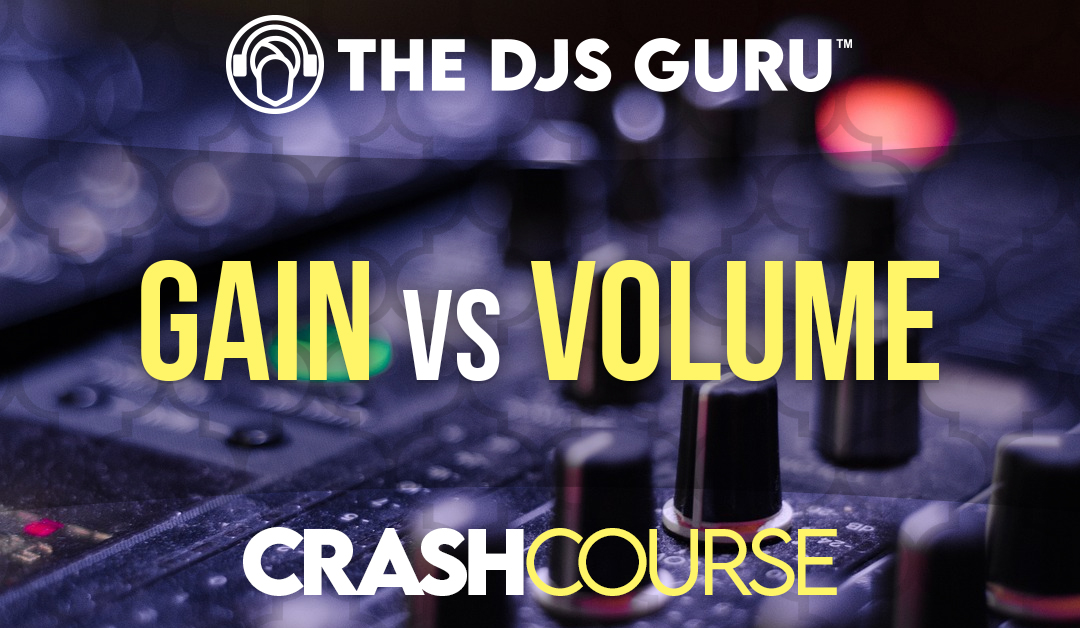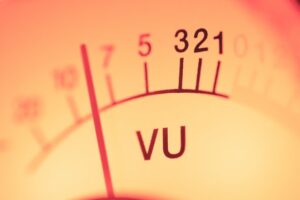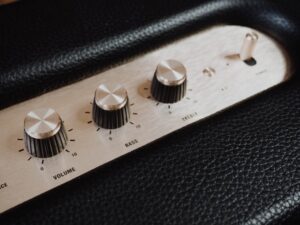Gain vs. Volume – What’s The Difference? Becoming a DJ, like many professions, requires you to learn a little lingo. Gigs, amps, hex LEDs, and moving heads can all be a lot at first. Two words that continuously trip up even the most experienced DJs, however, are gain and volume. Even those who think they understand them might be accidentally using them interchangeably. In this article, we’ll talk about what each means and why they’re important.
Visit DJSupplyStore.com for a curated collection of DJ Gear, Pro Audio and Lighting Equipment
What is gain?
Gain is a control that can be found on a lot of equipment – mixers, amplifiers, and powered speakers to name a few. You may also see it labeled as “trim” on your gear. Because of what happens when you turn a gain knob, most people assume it’s just a volume control. However, gain has a different function from volume, which we’ll discuss a little later. In essence, gain controls the level of something at the input stage, before any processing has happened to the signal. It’s usually the first point of adjustment you have over a signal, be it a Serato deck or a guitar.
When you send a signal into a mixer or a speaker, the first thing you want to do is make sure that it isn’t too strong. Too strong of a signal can overwhelm the circuitry and cause distortion. Distortion can alter the sound and potentially damage your equipment. While distortion is great for heavy metal guitar, it’s not usually desired for other musical settings. The gain knob can be used to adjust the level of the incoming signal to prevent distortion at the first step in your audio chain.
Different instruments and pieces of equipment have varying output signal strengths. When mixing multiple signals together, be it DJs or a band, it’s important to start with relatively equal levels. The gain knob can be used to bring every input up to the maximum level the mixer or speaker can handle without distortion. Now, you have a solid part to start fine-tuning the various instruments and audio signals.
Before setting gain
Like we mentioned before, proper gain levels give you the clearest signal without distortion. They also lead to better mixes overall, as your various inputs are better blended together. We want to make sure that we are taking advantage of as much of the strong signal our instrument or audio gear is sending us, so dialing in the gain to the maximum clear level is important.
So how do we get our gain to the right spot? Normally, gain knobs have a center “12 o’clock” position in the middle. It’s sometimes marked with “0 dB,” an infinity sign, or the letter U. This spot is called unity and we’ll refer to it as we talk about setting our gain structure. At unity, the mixer is not reducing the signal level coming into the channel. It’s also not boosting the signal in any way. So to start dialing in our gain, the first thing we want to do is make sure we are sending a strong signal to the mixer or the speaker. If you’re playing an instrument, bring its volume up to anywhere from 70-90% of maximum. For some quieter instruments, you may have to go even louder. For DJ mixers, phones, CD players, and other line-level sources, shoot for the same level.
Setting gain
Now that you’re sending a strong signal to the mixer, start bringing up the channel’s gain knob little by little. Next to most gain knobs (or somewhere on the mixer) is a small “clip” or “limit” light. If this light is turning on, it means your signal is too loud and possibly distorting. As you bring up the signal, watch for that light to turn on. Once it does, lower the gain knob until it is not illuminating or is only illuminating on the very loudest parts of the music. If your gain is below unity that’s great – the mixer or speaker did not have to boost the signal. Boosting the signal adds noise, so if we can avoid it we try to. However, some quieter inputs (like microphones) may need some boosting and you might have to go above unity. Just try to add the least amount you can.
Now repeat the process for the rest of your inputs. Congrats, you’ve successfully adjusted the gain of your mixer or speaker!
Visit DJSupplyStore.com for a curated collection of DJ Gear, Pro Audio and Lighting Equipment
Volume
Gain vs. Volume – What’s The Difference? Volume is a slightly simpler topic than gain. While gain was the level of a signal at the input, volume is the level of an output signal. When most people think of how loud something is, they are thinking of the volume. With a mixer, volume is the level of all the combined channels leaving through the master outputs. If you’re using a powered PA speaker, volume is the final adjustment that controls the dB level coming out of the speaker. And if you’re using an amplifier, volume controls how much power is going to the speaker cone.
Volume is usually the final adjustment made after all of the individual channel mixing has been done. Long before you set volume, you should have correctly set each channel’s gain, adjusted EQ, and added any effects you wanted. When all of that is done, you adjust volume to bring the entire mix up to the appropriate listening level.
The effects of volume
While gain can often play a much bigger role on the sound of your mix, volume should not be ignored. One of the classic ways people mess up the volume level is by going too loud. We discussed clipping (or overdriving) a signal at the gain knob and it can definitely occur at the volume knob as well. If you’re trying to send too strong of a signal to your amplifier you can end up burning it out as it tries to keep up.
Luckily, most amplifiers, mixers, and powered speakers also have “limit” or “clip” lights for the volume control as well. Keep an eye out as you bring up the volume that you are only occasionally causing the light to flicker during the loudest portions of the music. If your light is turning on and it’s not loud enough I have bad news – you need more power. In this case, it’s best to add additional speakers or a more powerful amp to cover your needs.
Gain vs. Volume – What’s The Difference? Wrapping it all up
So let’s review, gain vs. volume – what’s The difference? Gain adjusts the signal level coming into a mixer or speaker. It allows us to get the strongest and clearest signal possible without distortion. We can use the gain control to balance different inputs and instruments before fine-tuning our mix. Volume controls the signal leaving a mixer or coming out of a speaker. It controls the power of an amplifier and has the biggest impact over “loudness.” If our volume higher than our speaker or amplifier can handle it can damage our equipment. If this happens, we should add speakers or more power to make up the difference.
Congrats! Now you’re a master and know the difference between gain and volume.
We thank you for stopping by The DJs Guru community today, remember we are here to help you learn, grow and succeed so feel free to contact us with any questions or advice you may need. Continue to follow our blog for more educational posts like this and also gear reviews, tips and tricks and interviews. If you’re interested in the full experience you can learn more about our one on one coaching programs here. We’ll see you on the flip side!
Visit DJSupplyStore.com for a curated collection of DJ Gear, Pro Audio and Lighting Equipment




